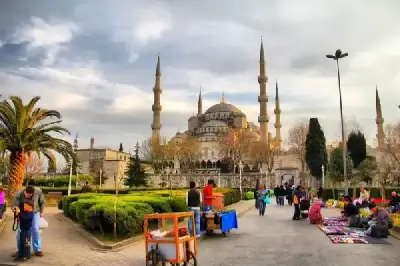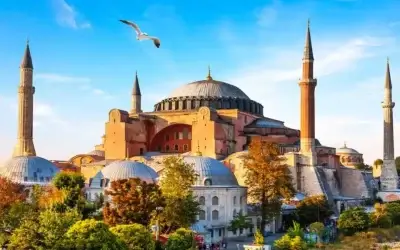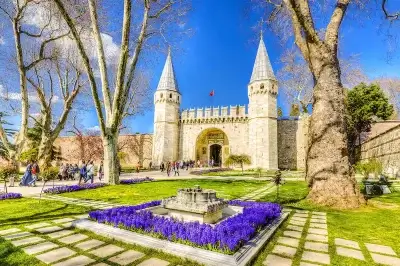The Historical Significance of Topkapi Palace
Constructed in 1459 by Sultan Mehmed II, also known as Mehmed the Conqueror, Topkapi Palace was strategically positioned on a promontory overlooking the Bosphorus Strait, the Golden Horn, and the Sea of Marmara. This commanding location not only provided breathtaking views but also served as a powerful symbol of Ottoman supremacy over both European and Asian territories.
The palace complex spans an impressive 700,000 square meters and consists of four main courtyards, numerous buildings, gardens, and pavilions. Throughout its active years as an imperial residence, Topkapi Palace housed up to 4,000 people, including the sultan's family, government officials, servants, and the famous Janissary guards.
Architectural Marvel and Palace Layout
The architectural design of Topkapi Palace reflects a unique blend of Ottoman, Islamic, and Byzantine influences. The complex is divided into distinct sections, each serving specific functions within the imperial administration and daily life.
The First Courtyard (Court of the Janissaries)
The outermost courtyard, accessible through the Imperial Gate (Bab-ı Hümayun), served as a public space where various ceremonies and gatherings took place. This area housed administrative buildings, the imperial mint, and storage facilities for provisions.
The Second Courtyard (Divan Square)
Entering through the Gate of Salutation, visitors reach the second courtyard, which served as the administrative heart of the Ottoman Empire. Here, the Imperial Council (Divan) convened to discuss state affairs, while the palace kitchens prepared meals for thousands of residents daily. The Tower of Justice, rising above this courtyard, allowed the sultan to observe council proceedings discreetly.
The Third Courtyard (Enderun)
The Gate of Felicity leads to the most private section of the palace, accessible only to the sultan and his closest associates. This courtyard houses the Audience Chamber, where the sultan received ambassadors and high-ranking officials, and the famous Treasury, displaying an extraordinary collection of jewels, weapons, and precious artifacts.
The Fourth Courtyard and Harem
The innermost section features beautiful gardens, pavilions, and the Imperial Harem, the private quarters of the sultan's family. These areas showcase the most exquisite examples of Ottoman decorative arts, with intricate tilework, calligraphy, and architectural details.
The Imperial Treasury: Jewels of the Ottoman Empire
The Treasury of Topkapi Palace houses one of the world's richest collections of treasures. Among its most famous pieces is the Topkapi Dagger, adorned with emeralds and diamonds, and the 86-carat Spoonmaker's Diamond, one of the largest diamonds in the world. The collection also includes elaborate thrones, ceremonial weapons, royal insignia, and priceless manuscripts.
The Sacred Relics Collection
Topkapi Palace serves as the guardian of Islam's most sacred relics, including items believed to have belonged to Prophet Muhammad. The Pavilion of the Holy Mantle houses these treasures, making the palace not just a historical monument but also an important spiritual site for Muslims worldwide.
The Imperial Kitchens and Porcelain Collection
The palace kitchens, once employing hundreds of cooks and staff, now display an impressive collection of Chinese and Japanese porcelain, considered among the finest outside Asia. Ottoman sultans were passionate collectors of fine ceramics, and the palace houses over 10,000 pieces of porcelain and silverware.
Visiting Topkapi Palace Today
Today, Topkapi Palace welcomes millions of visitors annually who come to explore its magnificent courtyards, ornate chambers, and priceless collections. The museum offers audio guides in multiple languages, providing detailed information about the palace's history and significance.
Best Time to Visit
Spring (April-May) and fall (September-October) offer the most pleasant weather for exploring the extensive palace grounds. Early morning visits help avoid crowds, especially during peak tourist season. The palace is closed on Tuesdays, so plan your visit accordingly.
What to See
- The Imperial Treasury and its world-famous diamonds
- The Sacred Relics collection in the Pavilion of the Holy Mantle
- The Imperial Harem (separate ticket required)
- The extensive porcelain and silverware collections
- The stunning views of the Bosphorus from the palace terraces
- The intricate Iznik tiles and Ottoman calligraphy throughout the complex
Topkapi Palace in Istanbul's Historical Context
Located in the Sultanahmet district, Topkapi Palace is surrounded by other iconic landmarks including the Hagia Sophia, Blue Mosque, and the Basilica Cistern. This concentration of historical sites makes the area the cultural heart of Istanbul and a must-visit destination for anyone interested in Byzantine and Ottoman history.
The palace's transformation from an active imperial residence to a museum in 1924, following the establishment of the Turkish Republic, marked a significant moment in Turkish history. This decision ensured that the palace's treasures and architectural splendor would be preserved for future generations.
Topkapi Palace stands as a testament to the grandeur of the Ottoman Empire and offers visitors an unparalleled journey through five centuries of history. From its stunning architecture to its priceless collections, every corner of the palace tells a story of power, culture, and artistic achievement. Whether you're a history enthusiast, architecture lover, or simply curious about Ottoman culture, a visit to Topkapi Palace is an essential Istanbul experience that will leave you with lasting memories of this magnificent imperial legacy.





